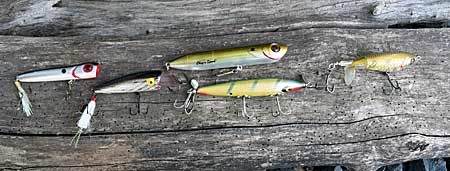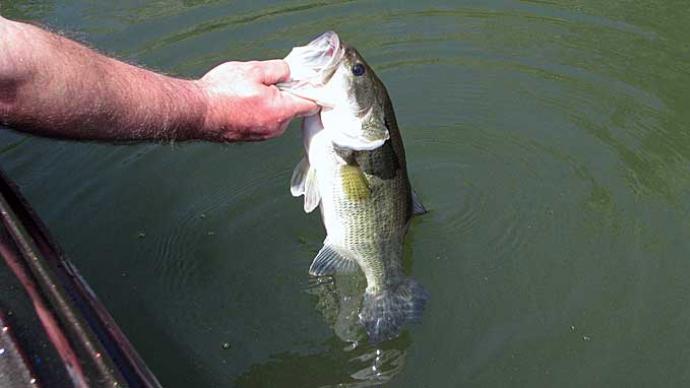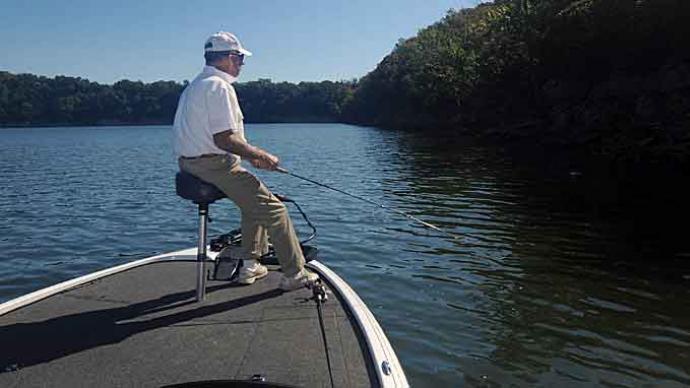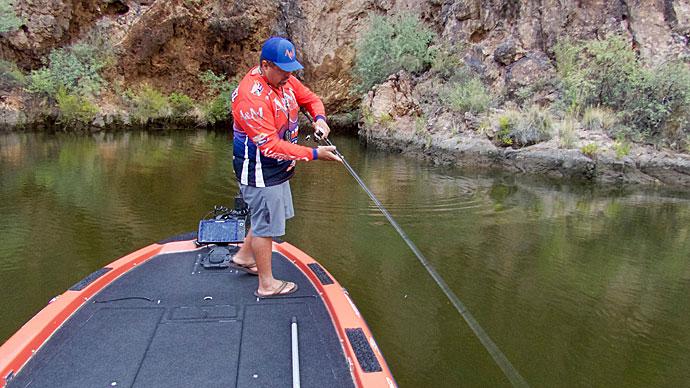
What would be your choice if I told you that you could open your tackle box and pick just one bait to go fun fishing for the day? I know right off the bat what my choice would be. It would be a topwater bait.
In my opinion, this is how bass fishing was made. Put a topwater bait in a new fisherman’s hand and let the bass blow up on the bait, and you will have signed up a new bass fisherman for life. There is no better bite in fishing than a bass flushing a topwater bait.
But topwater fishing for bass is not a pattern that you can fish day in and day out. The weather and the wind conditions somewhat regulate it. Windy days are the least favorable for topwater baits. But if the wind is calm or you're fishing in a protected area of the lake or river, it should be a bait that gets some consideration. There is no better and quicker way to go down the bank to see if you have bass present than with a topwater lure.
Let’s break down topwater baits and the best conditions to fish them and put a few tips in your back pocket at the same time.
Poppers
A popping topwater bait is your best choice when you have calm water areas. Storm’s Chug Bugs and Rebel’s Pop R are the top choices in this category. These two baits are the standard that has put these baits on the map in the popper category.
Make your cast and let the bait sit for about 10 seconds before you get the bait moving. At first, I like to give the bait a couple of pops and let it sit again before I start to walk it back to the boat. The bass often hit the bait after the first or second pop. The bait landing on the water got the bass’ attention and got him moving towards the bait. All it took was a pop or two to trigger the bite.
Start to work your bait back to the boat if it was not hit on the first couple of twitches. There are two distinct ways to retrieve a popper, one is to walk the dog, and the second is to give it a few pops, then let it sit for a few seconds and repeat. I mainly walk the bait back to the boat. I like to keep the bait moving but just like any bait, let the bass tell you what they want that day. I have had times when one retrieve would be the ticket one day but not get a single bite the next day. Try different retrieves and let the bass tell you what they want.
One tweak for poppers is to make sure that you add a feather or hair tail hook. Something triggers a bite when the bait is sitting, and I believe a tail hook dressing generates these strikes. As the bait is sitting in the water, the material on that tail hook is still moving, and my belief is this is generating the strike when the bait is sitting still.
Walking Topwater
Walking baits, as they are called, are the next category. The bait that put this category on the charts is the Zara Spook by Heddon. This bait doesn't pop. It walks across the surface in a back and forth motion called “walking the dog.”

In days of the past when everyone was fishing topwater baits on monofilament line, getting your bait to walk was a chore. But with many of the fishermen now using braided line for topwater fishing, walking the dog is a lot easier. Mono has a lot of stretch, so part of your twitch was lost before it even got to the bait, but now with the limited stretch that braid offers, it's much easier to get your Spook to move back and forth and walk the dog.
The best times to use a walking topwater is when you have calm water or has a ripple. Because of the bigger profile and commotion these baits put off, it's easier for the bass to find them when the water has a slight chop.
If you want to round out your walking bait arsenal, add a few baits that come equipped with props that create even more commotion than a standard walking bait. This will open up more opportunities to use these baits. If you get into an area known to hold bass and can't get them to commit to a regular walking bait, you can often get them to commit to a walking prop bait.
Plopper Bait
This is the easiest to fish of all the topwater selections as this is just a cast-and-retrieve presentation. The Whopper Plopper came screaming onto the bass scene in 2017, a remake of a lure that Larry Dahlberg designed. Larry had come to market in 2008 with a muskie version of the Whopper Plopper. It was somewhat successful in the muskie realm, but it also attracted the bass’ attention. Larry partnered with River2Seas and soon brought to market a bass version, and the rest is history.
Everyone likes the Whopper Plopper's power to attract bites from bass in the area. There is no cadence or special retrieve to learn the Whopper Plopper. It allows you to cover water twice as fast as any other topwater bait presentation, and you get to witness many heart-stopping strikes in the process.
Prop Baits
The final selection of topwater baits are the prop baits. Prop baits are great to use in off-colored water conditions as they can call bass from a distance. The bait that stands out in this group is the Devil’s Horse. The Devils Horse comes equipped with a prop at both ends of the bait.
Prop baits are best when worked in spurts, make your cast, and let the rings settle. Give the bait two good rips and let the bait sit. Keep repeating this until you get a strike. Another option is to make a cast and slowly reel the bait across the surface with a few pauses along the way.
Equipment For Topwater
Rod selection has changed a little through the years. In the past, you needed a little stiffer rod action. One of the biggest reasons for this is that you lost a lot of the lure movement from the amount of stretch in the monofilament line you were using. If you were using a medium-action rod teamed with a reel filled with monofilament, your bait never traveled far because of all the give built into your rod and line. This would make it hard to pop the popper or walk the when using a walking bait. You had to put a lot of action in your rod to get the bait to respond.

The introduction of braided lines to the mix changed how we fish topwater baits. Now it takes minimal rod action to get your bait to respond to your rod movement. It's easy to get your bait to walk or pop.
So, when it comes to rod choices, I'll fish a 7ft medium to medium-heavy action rod teamed with a 6.4:1 Lews BB-1 baitcaster. On this, I'll spool 18lb or 30lb Sunline Xplasma Asegai dark green braided line. For the Poppers, Walking, and Prop bait, I'll add a 12lb to 20lb Sunline Super Natural monofilament leader.
The reason for this is the braided line is so limp that as you're walking or working the bait, the braided line can get tangled with the bait. The mono leader keeps this to a minimum. If you want to go one step farther to keep the bait from tangling with the line, add a few bobber stops to your line and slide them down to the eye of the bait. This keeps the line far enough from the bait so it won't tangle. This simple tweak keeps your bait from tangling with your fishing line.
For the plopper baits, tie your braided line directly to the bait as the bass don't get that good of a look at the line before they strike the bait. The plopper is more of a reaction bite than anything else.
Topwater Tweaks
When it comes to topwater fishing, one of the most critical points is to make sure that your hooks are sharp. This is very important as the bass often miss the bait when they strike it. This is from the simple fact that you'll get the bass’ attention, and he starts to move toward the bait to strike, but at the last second, you again move the bait causing the bass to miss the bait somewhat. You will still get a solid hook-up if you have good sharp hooks. But if your hooks are dull, the chances are good that the bass won't be hooked well, and you'll lose the bass on the way back to the boat. Make sure you have good sharp hooks to start and check them a few times during your day of fishing on the water.
Setting the hook is another point that needs to be mentioned here. When you see that blow up on your bait, you're going to miss a lot of fish if you set the hook right away. Now, this will take some work on your part, but when you see the bass blow up on your bait, give it a 1-1000, 2-1000 count before you set the hook. Work on putting a 1 to 2-second pause before you set the hook. This tweak will make your hookup ratio go way up if you count.
How often have you been fishing a topwater, and while you're looking the other way, you hear the splash and then set the hook? When you were looking away, the bass had time before you reacted to the sound and got a solid hook into the bass. You didn't know this, but you gave it a 1 to 2-second pause before you set the hook resulting in a sold hookup and a bass over the side of the boat. Use this tip to catch more bass on topwater baits this season.
Many look at topwater fishing and say this is how bass fishing started. I don't know if that is true, but I can tell you why many fishermen get hooked on bass fishing. The first time you see a bass blow up on a topwater bait, you better check your pulse if that doesn't get your heart pumping. What makes bass fishing, so fun is the heart-stopping blowups on baits. You can tell it's going to happen. You just don't know when. That's the thrill of topwater bass fishing.
BassResource may receive a portion of revenues if you make a purchase using a link above.




